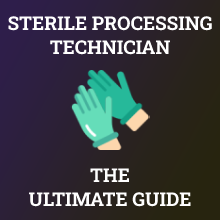Job Description
Sterile processing technicians are medical professionals who sanitize equipment and tools in a surgical area.
Also, these professionals prepare surgical units for emergency and scheduled surgeries using sterilization equipment like autoclaves to ensure all tools are decontaminated.
Sterile processing technicians also review a medical facility’s hygiene resources and track all sterilized equipment.
Duties
Their job duties include maintaining the equipment through preventative maintenance and making repairs as necessary.
Part of their training is identifying typical pathogens within a medical facility and applying proper sterilization techniques to ensure the equipment is decontaminated.
Part of most sterile processing technician training programs is infection control and microbiology.
Sterile processing technicians also must remain updated on skills regarding correctly cleaning the tools.
Additional duties include assessing contamination risks within a surgical environment, which helps the team keep patients safe and eliminate additional factors that could be problematic during surgery.
Storing and transporting sterilized equipment is also a critical aspect of the position.
Salary
A sterile processing technician’s median U.S. annual income is $45,800, ranging from $36,200 to $60,000.
The median pay is slightly more than the median annual income per person.
It’s important to note that different states and cities have different median incomes based on the local cost of living.
Also, those with longer internships and more comprehensive training programs will make more in entry-level positions.
Annually National Average Salary: $42,420
Average Annual Salary by State
| State | Avg. Annual Salary |
|---|---|
| Alabama | $31,430 |
| Alaska | $50,290 |
| Arizona | $39,340 |
| Arkansas | $33,860 |
| California | $55,930 |
| Colorado | $41,340 |
| Connecticut | $43,600 |
| Delaware | $44,610 |
| District of Columbia | $55,070 |
| Florida | $36,560 |
| Georgia | $38,870 |
| Hawaii | $49,740 |
| Idaho | $35,510 |
| Illinois | $43,170 |
| Indiana | $37,840 |
| Iowa | $36,300 |
| Kansas | $37,280 |
| Kentucky | $37,270 |
| Louisiana | $33,460 |
| Maine | $38,240 |
| Maryland | $40,630 |
| Massachusetts | $49,360 |
| Michigan | $39,220 |
| Minnesota | $44,420 |
| Mississippi | $31,310 |
| Missouri | $34,020 |
| Montana | $37,140 |
| Nebraska | $36,730 |
| Nevada | $43,910 |
| New Hampshire | $39,760 |
| New Jersey | $44,760 |
| New Mexico | $36,850 |
| New York | $45,840 |
| North Carolina | $36,460 |
| North Dakota | $41,450 |
| Ohio | $37,840 |
| Oklahoma | $34,800 |
| Oregon | $44,930 |
| Pennsylvania | $40,190 |
| Rhode Island | $45,060 |
| South Carolina | $38,440 |
| South Dakota | $33,390 |
| Tennessee | $36,820 |
| Texas | $38,860 |
| Utah | $40,210 |
| Vermont | $41,200 |
| Virginia | $36,900 |
| Washington | $46,170 |
| West Virginia | $37,670 |
| Wisconsin | $39,580 |
| Wyoming | $42,030 |
| Puerto Rico | $22,620 |
Annual Average Salary: Top 5 States
The top earning state in the field is California, where the average salary is $55,930.
These are the top 5 earning states in the field:
Conducted by: Bureau of Labor Statistics, Department of Labor.
* Employment conditions in your area may vary.
How to Become a Sterile Processing Technician
Step 1Finish High School
Employers always require a high school diploma to become a sterile processing technician professional.
To prepare for this career, taking medicine, chemistry, and biology courses is a helpful start.
While pursuing your high school degree, it’s important to research training programs in your city or state.
Depending on the enrollment process at the school, you could apply before high school graduation so you can start immediately upon graduation.
Step 2Select a Program
Community colleges and trade schools have sterile processing technician programs.
Depending on point the program type, completing the course can range from a few months to two years.
To best understand which program suits your career goals and budget, contact the institution and ask if you can observe a class to better understand the format and structure.
You could also interview students and instructors to hear firsthand options.
Step 3Talk to an Adviser
To learn more about the school and program, create a list of questions and make an appointment with an adviser.
They will discuss topics related to the field, share scheduling information, and provide course details.
Advisers can also assist with securing financial aid, which can help meet personal financial goals while pursuing the program.
Step 4Enroll in a Program
To enroll in a selected program, you must meet specific admission requirements.
For instance, some require candidates to complete entrance exams that evaluate problem-solving skills with a focus on coursework management.
Once the student is accepted into the program, the standard curriculum is comprised of the following classes:
- Disinfection and cleaning
- Infection prevention and control
- Inventory management
- Microbiology
- Physiology and anatomy
- Sterilization and decontamination
- Storing and using surgical instruments
- Surgical and medical terminology
Step 5Finish an Internship
While not all programs require an internship, applying for one while pursuing the educational aspect of this career is always beneficial.
Clinical internships help students utilize and develop the skills learned in the class and apply them in a practical setting.
In many instances, interns are given an offer for permanent employment post-graduation.
Step 6Choose and Pass the Certification Exam
Two accredited certification bodies exist for technicians: CBSPD (Certification Board for Sterile Processing and Distribution) and IAHCSMM (International Association of Healthcare Central Service Material Management.
Both organizations offer certification exams requiring work experience.
Most certifications are valid for five years.
The IAHCSMM examination offering requires 400 hours of practical experience in these areas:
- Decontamination
- Disinfection and sterilization
- Distribution and storage
- Equipment usage, management, and maintenance
- Quality assurance processes
- Packaging and preparing instruments.
The CBSPD exam has varying prerequisites depending on the candidate’s education and experience.
Professionals must complete one of these requirements:
- Twelve months of full-time work in the field.
- Six months of full-time work in a clinical healthcare role and completing technician responsibilities.
- Passing a technician course with a 70% or better grade.
- Working in healthcare product sales related to sterile processing equipment for 12 months.
Step 7Investigate Additional Education
Many healthcare professionals start in the medical industry as sterile processing technicians before earning additional degrees and advancing their careers.
For instance, a technician could consider improving management skills to accept more responsibility as a supervisor.
Others may take specialized courses to further their career by becoming a nurse.
Many sterile processing technicians advance in their careers with the following positions:
- Clinical medical assistant
- Licensed Practical Nurse
- Registered Nurse
- Sterile processing supervisor
- Sterile processing technologist
- Surgical technician
- Surgical technologist
Education
To become a sterile processing technician, a training program must be completed.
The process to enter a program includes the following:
One: Finish High School
Candidates must hold a high school diploma to enroll in any sterile processing technician program.
It’s beneficial to start this process during the junior or senior year so the training can begin right after high school graduation.
This allows learners to go into the medical community faster.
Two: Research and Apply to Programs
Sterile processing technician programs are available in all 50 states at colleges, trade schools, and online.
However, if you live in a rural area, you must go to a larger city or town to take classes or finish the program online.
The most important considerations when researching a program include accreditation, time commitment, cost, and reputation.
Three: Complete the Program
The third step is complete the classroom portion of the program so you can earn a diploma.
This is your entrance into the medical community.
Programs typically cover sterilization methods, medical terminology, equipment management and repair, basic microbiology, proper equipment storage, quality assurance and controls, and legal issues.
Four: Finish an Internship
The final step is to find and complete an internship.
Experiencing an internship is a critical aspect of gaining firsthand job experience.
This allows you to hit the ground running in your new profession.
Also, if you do a great job during the internship, many employers hire interns for permanent employment.
Video About The Career
Licensing and Certification
Two types of certifications exist for sterile processing technicians: full and provisional CRCST (Certified Registered Central Service Technician).
Full CRCST
Full certification requires candidates to log 400 hours of firsthand experience over the past five years before applying.
Hands-on experience is critical to improve the applicant’s knowledge of the position and prove the application of concepts.
Provisional CRCST
Provisional CRCST also requires 400 hours of firsthand training within six months of completing the certification exam.
Documentation of the requirements must be submitted to the Healthcare Sterile Processing Association before the six-month expiration date.
Those who do not submit the required information within this time forfeit the certification and must reply for the exam.
These two certifications are accredited by the ANAB (ANSI National Accreditation Board) and the NCCA (National Commission for Certifying Agencies).
The hands-on-experience requirement covers the following:
- Decontamination – 120 hours
- Equipment – 16 hours
- Packaging and preparing instruments – 120 hours
- Quality assurance processes – 24 hours
- Sterilization and disinfection – 96 hours
- Storage and distribution – 24 hours
Average Training Program Duration: 0-1 Year
Popular Programs
Job Outlook
Projected job growth over the next decade is around six percent, consistent with all U.S. occupations.
Most new openings result from existing employees retiring and others moving into other positions, many in the medical field.
This is a testament that the sterile processing technician role is an excellent introduction to the medical field.
Employment Growth Projection: 6%
2020
2030
That's a higher than average projected growth of 2,952 jobs.
Sterile Processing Technician: Interest Over Time
Should You Become a Sterile Processing Technician?
Overall Satisfaction: High

Most sterile processing technicians are satisfied with their career paths.
While the job can be stressful when an emergency arises, most sterile processing technicians have low stress throughout the day and work a standard 40-hour work week.
It’s important to note that sterile processing technicians don’t work directly with patients but collaborate with other medical teams.
Therefore, these professionals are helping others indirectly.
Average Salary: Medium

With a median pay slightly above the average income per person, at $45,900, becoming a sterile processing technician can make you financially stable, depending on your home state, city, and the associated cost of living.
Job Growth Outlook: Medium

The sterile processing technician field is expected to grow by six percent from 2021 to 2031, which is average for all occupations.
Approximately 9,600 openings for sterile processing technicians are expected each year over the next decade.
These openings are expected due to replacing workers who transfer into different occupations or retire.
Education Duration: 0-1 Year

The required educational time commitment to become a sterile processing technician ranges from a few months to two years, depending on the school and certificate or diploma.
Longer programs are more comprehensive, so graduates have more knowledge when entering the field, which could also impact their salary.
Personal Skills Needed

Although there isn’t any patient interaction, soft skills are still needed for dealing with other medical personnel.
The best sterile processing technicians have the following personal skills:
- Ability to solve problems quickly – equipment degrades over time, so fixing issues quickly is critical. Also, sterile processing technicians must be prepared for emergencies, even when it conflicts with scheduled surgeries, so allocating tools properly requires decisiveness and problem-solving skills.
- Communication – like with any role, especially in the medical field- is imperative to success. When working with other medical professionals, being able to communicate is the foundation of a successful career. This is not a skill that is developed through education but is improved through experience.
- Detail-oriented – sterile processing technicians must follow strict guidelines for sterilizing equipment to ensure it’s safe for patient use. Also, maintenance and repairs are required, so being detail-oriented is essential.
- Healthcare skills – most employers require sterile processing technicians to be able to administer basic life support and be CPR certified.
- Team-focused – working well with other medical personnel and in teams is an important part of being a sterile processing technician. Other teams rely on these professionals to ensure all surgical equipment is ready immediately.
Frequently Asked Questions
Q. How long must you attend school to become a sterile processing technician?
The time commitment varies based on the program and school, but sterile processing technician training generally requires a few months to two years.
The longer a student is in school, the more knowledge is gained, so it’s easier to transition into the medical community.
Also, many programs require internships, giving students hands-on medical community training.
Internships also often lead to permanent employment post-graduation.
Q. How much money does a sterile processing technician make per year?
The typical sterile processing technician in the U.S. will make $45,900 annually.
This amount is impacted by the amount of training received and location.
Q. What kind of education do you need to become a sterile processing technician?
Completing a sterile processing technician program is required to become a professional within the medical industry.
A typical program takes a few months and up to two years, depending on the program format and whether an internship is required.
The longer the program, the more knowledge the candidate will gain, thus offering better preparation for a medical environment.
Q. Are sterile processing technicians in high demand?
Sterile processing technicians are not in high demand, and while the field is expected to expand over the next decade, it’s at an average rate.
Only a few jobs will be created; most openings will be because of movements between careers and retirement.
Q. What skills do you need to be a sterile processing technician?
Sterile processing technicians need a combination of technical and soft skills to be successful.
The most important skills include:
- Attention to detail – since this position requires safely preparing medical equipment, sterile processing technicians rely heavily on attention to detail to ensure the process is followed and all steps are effectively completed.
- Basic healthcare skills – sterile processing technicians work in medical facilities, like hospitals and dentist offices, so most employers require basic life support and cardiopulmonary resuscitation training.
- Collaboration – part of the job is to work with various medical personnel to prepare equipment. Therefore, collaborating with other teams while preparing equipment promptly is critical.
- Communication – technicians have ongoing contact with other medical personnel to prepare surgical units, schedule equipment repairs, and provide various status reports.
- Problem-solving – in some instances, sterile processing technicians prepare an operating room for a scheduled surgery when an emergency occurs. At this time, sterile processing technicians evaluate risk factors and make informed decisions on distributing resources and utilizing sterilization equipment. Therefore, they rely heavily on problem-solving skills to generate a solution.









